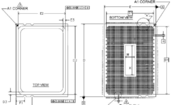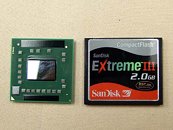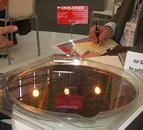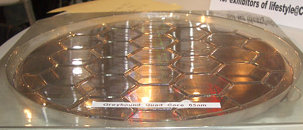
AMD wants to leave the Barcelona (rather K10) debacle behind it as it moves closer to a newer processor architecture. This paves way for AMD to incorporate strong memory and system interface links. The G34 socket though touted to be a successor for the current socket 1207, is believed to be a standard socket for both enterprise and PC processors. AMD is working on a new CPU architecture codenamed 'Bulldozer'. Derivatives include monolithic 8-core and 12-core processors. The 12-core processor is now codenamed Magny-Cours, the 8-core part is called Sao Paulo. These processors could feature four parallel HyperTransport 3.0 interconnects, upto 12 MB of L3 cache and 512 KB L2 cache per core. It's known that AMD could be working on quad-channel DDR3 (both registered DDR3 under G3MX and unregistered). Socket G34 seems to have 1,974 pins.
The provision of four independent HyperTransport interconnects means that the fourth interconnect can be dedicated as a peer-to-peer interconnect between two sockets in a dual-socket setup, or its bandwidth split to form daisy-chains with multiple sockets. A prelude to AMD's Torrenza enterprise platform, which would allow use of several co-processors of different architectures including ClearSpeed to be embedded in workstations.

The first systems running Advanced Micro Devices Inc.'s new quad-core Barcelona chip are expected to hit the market in April, AMD executives said today. Pushing the delayed processor out into the market will give the company a boost in what has been a lagging competition with rival Intel. Kevin Knox, vice president of AMD's commercial business reported that a series of hardware vendors, including Hewlett-Packard Co., IBM, Sun Microsystems Inc. and Dell Inc., will be launching Barcelona-based servers between now and the end of the second quarter. "We're pretty excited about that because it opens us up to a market we hadn't played heavily in before," said Knox, acknowledging that Barcelona is four to six months late because of the Transition Lookaside Buffer (TLB) bug in all Barcelona and Phenom chips. Now after the B3 stepping is finally starting to ship, AMD is gradually starting to place Barcelona chips in major server brands.

AMD CEO Dirk Meyer had something to say to the press today, and it was something along the lines of bungling (I love that word) the Barcelona launch. As The Inquirer so eloquently puts it, Barcelona "was hyped as the best thing since nylon stockings. In the end it was launched six months late, failed to work then, and is now adrift on high seas, apparently following its arch-competitor's Itanic on a trip to Laughing Stock Island." As far as an official statement goes, Dirk Meyer had this to say regarding Barcelona:
We haven't delivered our quad core product according to plan. We'll make good on our promise to deliver hundreds of thousands of quad core processors, but we're disappointed. We blew it, and we're very humbled by it. And we learned from it, and we're not going to do it again.
If AMD's financial records continue their abysmal performance, and the stock continues sinking below the four-year low it currently is at, AMD may not have too many more chances to redeem their reputation.

AMD has just released a statement detailing the latest developments regarding their Quad-Core Barcelona processors.
The topics are regarding:
- For the initial ramp up "hundreds of thousands" processors were promised.
- TLB cache issues
- Quad-Core AMD Opteron availability
- AMD Opteron market share

Today, AMD released the first of what will be two major upgrades to their AMD Core Math Library (ACML) in the coming year. This first includes support for Barcelona's native 128-bit SIMD engine. It works with Windows, Linux and Solaris, and doubles the floating point operations per clock to 8 on Barcelona, up from 4. The major upgrade next year will include direct support for heterogeneous processing using their recently announced FireStream 64-bit stream processor. The refresh brings ACML up to version 4.0. The library is available for free download and includes enhancements to their base math algorithms. These include Level 1, 2 and 3 Basic Linear Alegbra Subroutines (BLAS), Linear Algebra (LAPACK) routines, Fast Fourier Transforms (FFTs) in single, double, single-complex and double-complex data types, scalar, vector, array and transcendental math functions. A pseudo-random number generator is also included with both single and double precision generation. AMD has worked with PathScale, PGI and Sun, as well as Microsoft and the Linux community at large, to include special optimizations and native library support in their products. AMD also has a CodeAnalyst tool, which is similar in function to intel's VTune, though with a lesser set of comprehensive abilities. It is also available for free download.

AMD today announced it is demonstrating platforms based on Quad-Core AMD Opteron processors, including features designed to help Microsoft Windows application developers optimize their software applications through tools in upcoming software products from Microsoft Corp. The technology demonstrations at the conference in Barcelona, Spain show new integration with Microsoft Visual Studio 2008 and Quad-Core AMD Opteron processors.

Gateway, Inc., the nation's third largest PC vendor, will offer the powerful new Quad-Core AMD Opteron processors in its entry-level tower server and complete line of rackmount servers. The new AMD processors feature four cores on one piece of silicon in the same thermal envelopes as the previous generation of dual-core AMD Opteron processors, for an increase in performance without an increase in heat generation.

AMD today introduced the Quad-Core AMD Opteron processor, the world's most advanced x86 processor ever designed and manufactured and the first native x86 quad-core microprocessor. Designed from inception for the most demanding datacenters, Quad-Core AMD Opteron processor-based servers from global OEMs and system builders can deliver breakthrough capabilities to customers in a time of dramatically escalating performance-per-watt emphasis.

AMD today announced that it will hold its Premiere Event for the launch of the Quad-Core AMD Opteron processor at approximately 6:30 pm Pacific Time (9:30 pm ET) on Monday, Sept. 10, 2007. The event will be webcast live and can be accessed
here. A replay of the webcast can be accessed at this site approximately one hour after the conclusion of the live event and will be available for 10 days after the event. The webcast will also be available at
AMD.com.

Barcelona should be available next week and when compared with Intel's Clovertown, Barcelona is 30% faster than Clovertown at floating point instructions. However, at integer instructions, Clovertown is approximately 30% faster than Barcelona. Dell also says they will continue to use AMD processors in their line up to give their customers a variety of choices to choose from.

AMD plans to launch nine new quad-core processors later this month with clock speeds ranging from 1.7 GHz to 2.0 GHz. The initial launch will only have two thermal bins, 68-Watt and 98-Watt TDP. AMD's two-way capable quad-core Opteron 2300 series launch with five new models. Pricing for the two-way capable models start at around $206 and go up as high as $372. On the multi-way side of things, AMD has four quad-core Opteron 8300 models starting at a $688 entry price all the way up to $1,004. Desktop users will have to wait until Q4 of 2007 for AMD's Phenom to experience quad-core.

With the passable launch date of September 10 there seems two be a couple of problems with the chip and compatibility. It seems that the Dual Dynamic Power Management will not work without a BIOS update, and with a supported motherboard. This is something to be expected from knowing that some features will not be supported on former socket types.
"It seems the CPU itself is capable of engaging in CoolCore operations, but not Dual Dynamic Power Management (formerly "Split Plane," which allowed each core to operate independently with different voltages and clock speeds). It won't be able to handle these power saving and performance enhancing aspects of operations from the core alone. The motherboard must be brought into the mix in an active way to help reduce power consumption and save energy when the many cores are not in high use."
The other issue while not truly being an issue is the 128-bit floating point. There simply isn't any software on the market to take advantage of it. Hearing something like this isn't new to the PC market at all. The 64Bit CPUs are just now starting to see the light after a few years of their release, and Dual core CPUs are also just now starting to be implemented into applications. It's safe to say that the 128-bit floating point technology may take some time before developers start using it.

Advanced Micro Devices announced during the most recent teleconference with analysts that its Fab 36 had been fully converted to modern process technology and also said that the yield of those products was high enough.
Our Fab 36 conversion to 65nm is complete, with yields exceeding expectations and we now turn all our attention to 45nm [transition]
said Dirk Meyer, the president and chief operating officer at AMD, during the conference call.
As a result, AMD's first 65nm quad-core Opteron processors code-named Barcelona will be introduced in August or September, but will only run at 2.0GHz, whereas faster parts are projected to become available in Q4 2007.

Intel has been creating waves with the new Centrino Pro/Duo plattform (although they dropped the "plattform" part) and AMD is trying to stay in the news. They have now shown off the upcoming Griffin CPU at the Microprocessor Forum 2007. The CPU itself is about as big as a compact flash card. I will come in combination with the RS780 Chipset, which features up to 14 USB 2.0 port & 6 SATA ports. Intel's Robson (or Turbo Memory) will be taken on by AMD's Hypermemory offering. There will be support for HDMI and DisplayPort as well. All this should be available in mid 2008.

In response to AMD's Barcelona benchmarks Intel demoed its V8 platform. Two quad core Xeons at 3GHz with 16GB RAM score an impressive 4933 pixels per second in POV-Ray. In comparison AMD's quad quad core Barcelona (16 cores total) score just over 4000 pixels per second. Even though AMD did not mention the clockspeed and said the final version will run faster AMD still uses 16 cores while Intel uses 8. Of course Barcelona is not yet a final product, Intel is not impressed though.
Besides that Intel also demoed a Penryn which outperformed the current top of the line quad cores by 40%, quite impressive.

[H]ard|OCP has taken a few snaps of AMD's Barcelona system, displayed at AMD's event in Monterey, California.
What you see in the pictures below are single processor and dual processor configurations. Take note, those are Radeon X2900 XT video cards in the systems. Ian McNaughton showed off both systems encoding a 1080P trailer of Spiderman 3 to an H.264 format. On the dual quad-core Barcelona machine the encoding nearly ran real time.

Chip maker AMD is struggling financially at present, largely due to the $5.4 billion acquisition of ATI last year. The company had already reported a net loss of
$611 million for the quarter ending March 31st, but it has now been forced to raise finance by offering Convertible Senior Notes to investors. These differ from stocks because AMD will have to pay back the money it has raised once its stocks hit a price of $42.12 (the current price is at $14) which is essentially plunging the firm further into debt. Analysts are now worried that AMD could run out of cash by the forth quarter of this year if it doesn't borrow more money, with an estimated figure of just $1.1 billion in the bank. Meanwhile, AMD's closest rival Intel is in it's
strongest market position since 2005, with profits of
$1.6 billion in the first quarter of 2007. AMD will be banking on the new
Barcelona core and the R600 series of graphics cards to help it back onto its feet.

AMD is claiming that its new quad-core Barcelona processors could outshine Intel's Xeon processors by as much as 50% in floating-point performance, as well as having a 20% advantage when it comes to integer performance. However, despite this claim, the actual benchmarks for the SPECcpu2006 test seem difficult to come across on AMD's website - despite AMD supposedly giving a link - so it's difficult to verify at present.
Luckily, it's much easier to find the results comparing AMD's new Opteron 2222 processor and Intel's 3.0GHz Xeon 5160. These show AMD enjoying greater performance by
as much as 15% in some SPUCcpu2006 tests, which it credits to its Direct Connect Architecture and DDR2 memory. Obviously it would be a good idea to take these results with a pinch of salt considering they come directly from AMD, but Barcelona certainly looks promising.
Read on for the complete press release.

Fuad has word that the upcoming K10 server processor codenamed Barcelona is 50 percent faster in specfp_rate2000 then Intel's quad core Kentsfield. As the CPU speed was not disclosed it will be near the stated 2.5GHz which applies for its fastest desktop counterpart, the Agena FX. The slowest Agena's will however start at 1.9GHz and will have the 95W TDP for sure.

With all the recent and not-so-recent processor releases Intel has made, and all the recent-but-buggy NVIDIA graphics card releases, it's no wonder that AMD (which owns ATI) is losing some of its market share. All AMD can do to try and maintain market share in the USA is to continue to cut prices of existing products, while Intel and NVIDIA enjoy the performance crowns. However, all this is bound to change when AMD unleashes Barcelona. AMD told TGDaily that the Barcelona processor core is on schedule. However, to ensure enough stock at launch, we may not see the Barcelona core until Q4 2007, or maybe even Q1 2008. AMD is likely to regain some graphics card market share back with the HD 2x00 series.

Besides the usual R600 and K10/Barcelona talk that keeps us busy all day long there is another side of AMD that many people don't seem to realize: the financial part. If you are interested on being reading some well written thoughts I would suggest a recent two-part article at Overclockers.com. There Ed Stroligo explains AMDs actual financial situation with all the losses of revenue during the last quarter and gives some forecasts on how AMD will react to this.
Get to the
first part here and don't miss the
second part.
Btw.: There are several other interesting articles about various subjects of the computer sector at their
front page.

The soon to be released next CPU architecture named K10 was
x-rayed a while ago. We know that the K10 won't hit the 3GHz mark, it will come in all flavors from 2.1GHz all the way up to 2.9GHz. What we missed there, and what AMD didn't let out of their labs yet, was a corresponding heat dissipation figure. Now as
Fudzilla.com acts like their silent megaphone they tell the public that 95W will be the maximum TDP for Barcelona and Agena FX. That is quite low for a real quad-core CPU, and sounds very promising in terms of overclocking achievements.

It turns out that AMD has been producing Barcelona wafers for a while now. We thought you'd be very interested in the pictures that The Inquirer got for everyone that couldn't catch a plane to CeBIT in Germany.

Interesting news from AMD: It plans to sort of launch it's upcoming K10 CPU on this coming monday if one can trust an
interview of two AMD spokesmen at the french website Syndrom-OC.net. In this interview Giuseppe Amato (Technical Director, Sales and Marketing EMEA) and Philip G. Eisler (Senior Vice President, Chipset Division) are talking about the transition of the K8 to it's 65nm version, the K8L (L = Low Power). Furthermore they are explaining the new features AMD implemented into the Barcelona core and prove the rumor that it will come with 2.6 GHz only at the release.
Head on to
Syndrom-OC.net to get the whole story.

It seems
AnandTech has got another world's first - this time AMD's Barcelona core was examined. Anand Lal Shimpi reveals all the details you will need regarding the overall chipdesign, it's memory controller, pipeline and the other major and minor of it's features.
Have a good read but don't expect any benchmark figures... ;-)








